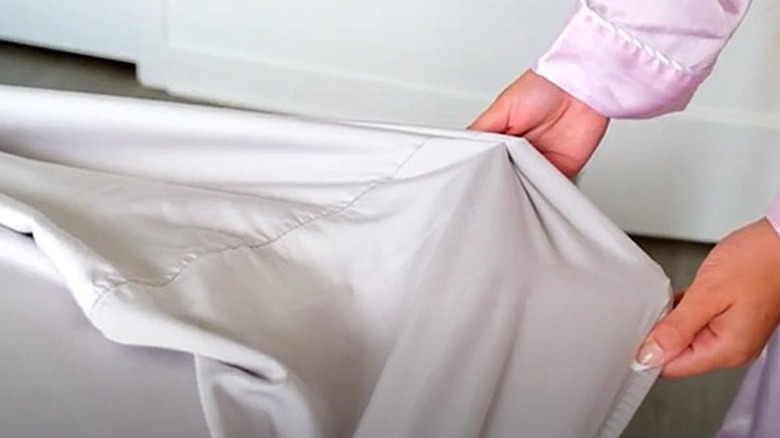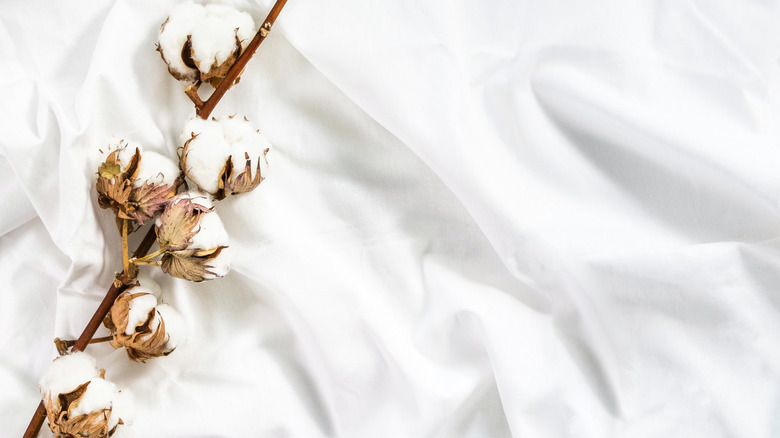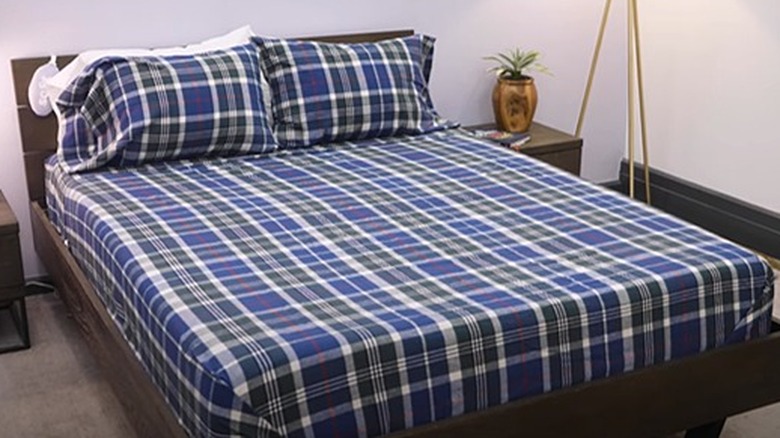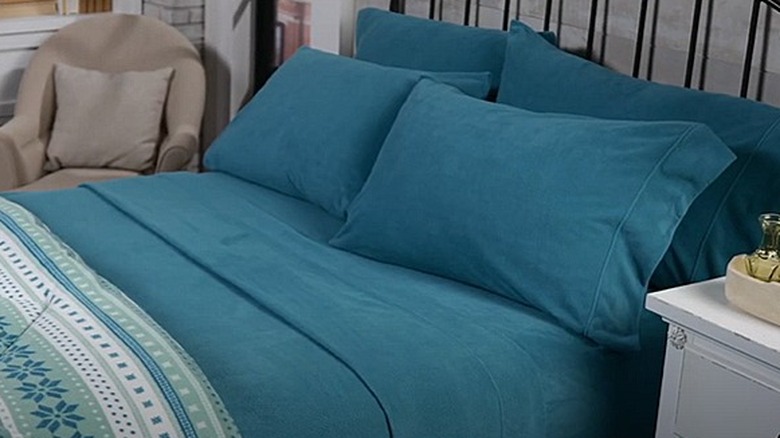5 Warm And Cozy Sheets You Need For Your Bed This Winter
Tired of layering up the bed through cold winter nights? You might consider investing in some quality sheets come winter that is both comfortable and warm. Known for their breathability, gentle texture, and warmth, cotton and flannel sheets are often popular among sleepers during frigid months. Luxurious fabrics like silk, bamboo, and cashmere also offer superior benefits, as they may absorb moisture and retain heat. Cotton and many other materials with high thread count will be one of the softest choices. Although in comparison, bamboo linens have been known to possess superiority in their delicate texture, via Sleep Advisor.
So, which sheets provide the ultimate comfort while keeping you warm at night? Depending on your preference, there's a multitude of selections. In your sheet search, you might also consider whether a product is naturally made or artificial. A wide variety of organic linens, often manufactured with bamboo, cotton, or silk, may come with a loftier price. For a cheaper yet warm synthetic option, microfiber and polyester are prime choices, although they tend to be more stagnant. You can cuddle up with warm and stretchy jersey knits or luxurious silk and bamboo while the snow falls outside. Keep reading to discover some of the best sheets you'll want to wrap yourself in this winter.
1. Bamboo
Bamboo is a perennial plant that is incredibly diverse and hardy and known for its versatile capabilities. Often made into kitchenware and flooring, among other products, bamboo can also be transformed into some of the softest and most luxurious sheets. Both cool and warm bamboo linens feature excellent moisture-wicking properties that extract moisture from the fabric, which keeps things dry and comfortable while you sleep, via REI. With prime breathability, the material naturally adjusts to your body temperature while helping you stay warm on those bitter, cold nights — or cool if it gets too hot.
Per this benefit, the material maintains an illustrious look and feel after each use, although it can wrinkle and shrink somewhat from its original size. Bamboo can be responsibly sourced without damaging its production, as its linens are available in various organic, eco-friendly options. Additionally, although these types of sheets may be on the higher end, they may be a good investment to use beyond the winter months. From earthy neutrals to vibrant shades, bamboo sheets come in various colors while being a healthy option for you and the environment.
2. Cotton
Soft and natural, cotton has been a reliable fabric source for centuries. Used to make numerous items like clothing, linens, and furniture, cotton continues to warm and comfort our daily lives, primarily through bed sheets. With longevity and good circulation, cotton sheets have a reputation for being an all-around sheet, including wintertime. You might look to Egyptian, Pima, or Supima for a 400 to 700 thread count for the softest and most enduring cotton linens. According to HGTV, a reasonable thread count could range from 200 to 800, with 400 being an ideal number.
Other types of woven cotton, like sateen or percale, are excellent choices, as they may withstand colder nights while providing solace and breathability. Some flannels and fleeces can also consist of cotton, which gives a similar feel with further insulation. Natural and affordable, cotton sheets are available in endless colors, designs, and thread counts. Additionally, organic linens may last longer than conventional types because they lack the harmful chemicals that are often included in them. Besides keeping your skin safe from supplementary chemicals, organic sheets won't be broken down as quickly as non-organic options.
3. Flannel
From a snowy winter's night to waking up Christmas morning, flannel sheets may reign supreme in cozy therapy. Delicately fuzzy and lightweight, flannel sheets may be one of the top choices for winter that will keep you continuously snug and warm. Established around the 17th century, flannel sheets may consist of cotton, wool, synthetic polyester, or other mixed fibers. A brushed fabric, flannel sheets come in various designs and colors, including holiday, floral, and the classic plaid farmhouse pattern pictured above. Flannel sheets receive their soft, yet wooly texture through a unique manufacturing technique called napping, via Sleepopolis.
For ultimate comfort and airiness, ensure your flannel sheets are marked as napped on both sides and made from 100% cotton. If you require a winter sheet that provides maximum warmth, you might seek wool or micro flannel set. Micro flannel is more budget-friendly than cotton and may last longer, as the synthetic fibers won't break down as much.
4. Fleece
Fleece is the optimum selection for a calm winter's night as it offers the toastiest insulation. Amidst snow-capped mountain ranges and long, dark Alaskan nights, fleece will keep you warm and tight compared to flannel, yet be aware of its sluggish circulation, via Boll & Branch. Often made of synthetic polyester fibers, fleece sheets are thick, like a blanket in texture and appearance, and there may be no need for an extra layer of pajamas. In general, fleece is thicker than most sheets providing additional protection, although your body heat may get locked in without a healthy escape by failing to regulate the temperature. Keeping this warm may reduce your house or cabin's heating costs at night.
Intended to compete with wool, polar fleece was established in the late 1970s as a collaboration by textile manufacturer Malden Mills and the outdoor Patagonia brand. Since then, they have offered a variety of colors that are often knit, which can make fleece more flexible and manageable overall. Look for double-sided, brushed knit fleece sheets for a soft and cozy night's sleep.
5. Jersey
Wrap yourself up in jersey sheets that are soft, stretchy, and made for cozy. A single-knit cotton jersey sheet might be a superb selection for kids, college students, or house guests, including those who seek extra warmth and comfort during the winter. Easy to manage on and off the bed, jersey fabric is naturally elastic, as it was initially used as a material for fisherman's undergarments on the Channel Island of Jersey. Originally made of wool, you can now find jersey-knit sheets in 100% cotton or a cotton blend with synthetic and polyester fibers. While pure cotton jersey sheets may have more optimum airflow during the night, cotton-blended types will aid in retaining heat to keep you warm and secure. Like an oversized, stretchy T-shirt, all-natural cotton types may also maintain their shape after washing, while the synthetic might hold up better over time.
Additionally, Jersey sheets are available in many colors and designs, including organic options. According to Sew Insider, styles with high thread counts may be comparable to Egyptian cotton regarding endurance. You could also use jersey sheets during the summer, but they will help insulate you while you sleep during the cold months.





